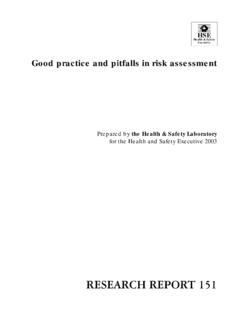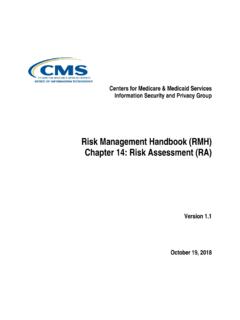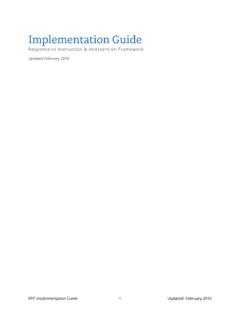Transcription of Risk Assessment Policy and Procedures Policy - LSI
1 LSI Independent Sixth form College Risk Assessment Policy and Procedures Policy Introduction and Objectives The purpose of this Policy is to enable the College to meet its duty of care to pupils and staff (and others) by creating a culture of undertaking risk assessments to reduce the risks of all College business operations, as far as is reasonably practical. The aim is to protect the health, safety and wellbeing of pupils, staff, visitors and others affected by our operations. This Policy and associated Procedures provides a framework for staff to follow in the completion of risk assessments. The Management of Health and Safety at Work Regulations 1999 dictate that the College has an absolute duty to carry out risk assessments to ensure such obligations are met.
2 The Independent School Regulatory requirements demand that the College ensures the welfare of pupils is safeguarded and promoted by the drawing up and effective implementation of a written risk Assessment Policy ; and that appropriate action is taken to reduce risks identified. The College must take a proactive approach to managing risk, and thereby reduce the likelihood that pupils (and others) will be harmed through negligence and lack of foresight or proper planning. The purpose of Risk Assessment By focusing on prevention, as opposed to reacting when things go wrong, it is possible to prevent accidents and injuries that could ruin lives, damage reputations and cost money.
3 Once a risk Assessment has been completed the significant risks must be communicated to staff and others, to enable their co-operation and informed decisions. Such communication can be done verbally, or where appropriate more formally by providing a copy of the risk Assessment and discussing the findings during a team or department meeting. What is a risk Assessment ? Risk Assessment is a tool for conducting a formal examination of the harm or hazard to people, particularly in the College s case to staff and pupils that could result from a business activity or situation. A hazard is something with the potential to cause harm. A risk is an evaluation of the probability (or likelihood) of the hazard (harm) occurring.
4 A risk Assessment is the resulting Assessment of the severity of the outcome ( loss of life, destruction of property). Risk control measures are the measures, actions and Procedures that are put in place in order to minimise the consequences of unfettered risk ( staff training, appropriate supervision, clear work Procedures , preliminary visits, warning signs and barriers). Risk assessments are used to identify the potential hazards to people from the College s activities ( safeguarding related, site security, slipping, falling, poor health, equipment, sports, recreation), property (fire), strategic (reputation, loss of pupils, impact on development), financial (falling pupil rolls), compliance (data protection) and environmental (hazardous waste).
5 Responsibilities for Risk Assessments The College s responsibility It is the College s responsibility, through its management, to ensure risk assessments are completed and implemented. The work involved to meet this responsibility is delegated to key roles within the school; namely teachers, Heads of Department if applicable ( Science), their direct line managers ( Vice Principal (Academic/Pastoral) and the Health and Safety Manager. This responsibility includes recognition of the particular nature of the College as a boarding school and the associated risks security of pupils. The Health and Safety Manager monitors and evaluates risk assessments, and reports on risk Assessment to SLT and the proprietor.)
6 LSI will provide suitable and sufficient training for staff required to complete risk assessments to ensure staff have the knowledge and understanding to fulfil this responsibility and undertake effective risk assessments. The teachers and Heads of Departments or Managers have control over the activities in that department and therefore need to ensure decisions made take into account safety requirements. A key way to achieve this is by completing a risk Assessment and ensuring work activities within the department are carried out safely. Heads of Departments, if applicable, or Managers are responsible for ensuring appropriate risk assessments are in place and reviewing them to ensure the risk Assessment accurately reflects operations and activities in their department.
7 Heads of Department or Managers should ensure that risk assessments are stored on the shared area for ease of access and reference. Heads of Department or Managers should ensure department risk assessments are reviewed regularly, after an incident/accident or at least on an annual basis. Line managers are expected to ensure this happens. Responsibilities of all staff Specialist training is given to those whose work requires it. However, staff are responsible for taking reasonable care of their own safety, together with that of pupils and visitors. They are responsible for cooperating with the health and safety Policy and arrangements (including risk assessments) and members of the SLT in order to enable the Governors to comply with their health and safety duties.
8 Finally, all members of staff are responsible for reporting any risks /defects or concerns to their line manager. General Arrangements Each department is responsible for ensuring risk assessments are in place for all work activities. The Health and Safety Manager will work with all departments to provide advice and support. General risk assessments should consider the following generic hazards: Safeguarding of pupils Manual handling Working at height Slips and trips Hazards from equipment/machinery used Lone working Substances hazardous to health (COSHH) Noise Access and egress Preventing unauthorised access to high risk areas Pastoral risk assessments These are either written and recorded or completed orally in a group setting.
9 Safeguarding risk assessments are confidential and prepared by the DSL and the Deputy DSL. These are stored on the relevant pupil s safeguarding file. Information is shared, where needed, to protect individuals. Supervision requirements for an activity or in boarding houses will most often be considered in a group session. Educational Areas There are number of higher risk pupil focused activities which take place at LSI, each of which requires risk Assessment : safeguarding, child protection, and Prevent science experiments each sport and PE activity art activities and equipment (including the clay and print studios) Those leading trips, are responsible for the completion of risk assessments, and the Health and Safety Manager.
10 LSI subscribes to the CLEAPSS Advisory Service ( ) that provides model risk assessments for activities in Science and Art and Design. Classroom and office risks In line the HSE s guidance, the College has created and uses a generic Health and Safety Checklist for classroom use, such as English, History and Geography classes. The Health and Safety checklist will be provided to teachers annually, each teacher should complete the checklist and return it to the Health and Safety Manager. All teaching subjects will be asked to complete the H&S checklist to assist with providing a safe environment for teaching and learning to take place. office staff will also be requested to complete a simple health and safety checklist, although these are low risk work environments it is important to ensure safe access/egress, suitable lighting and ventilation for example.





